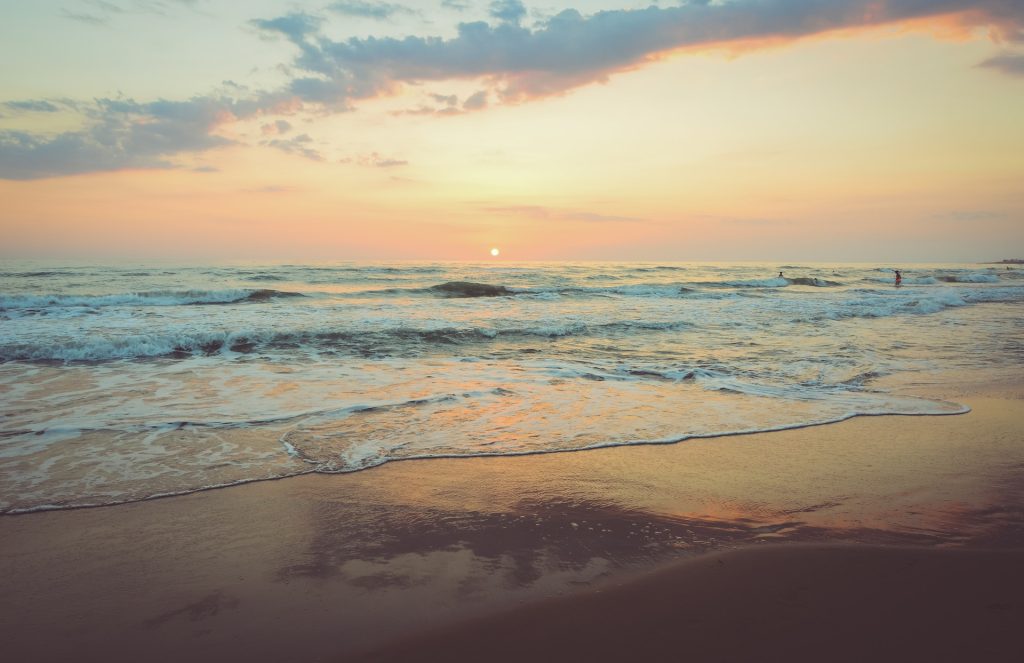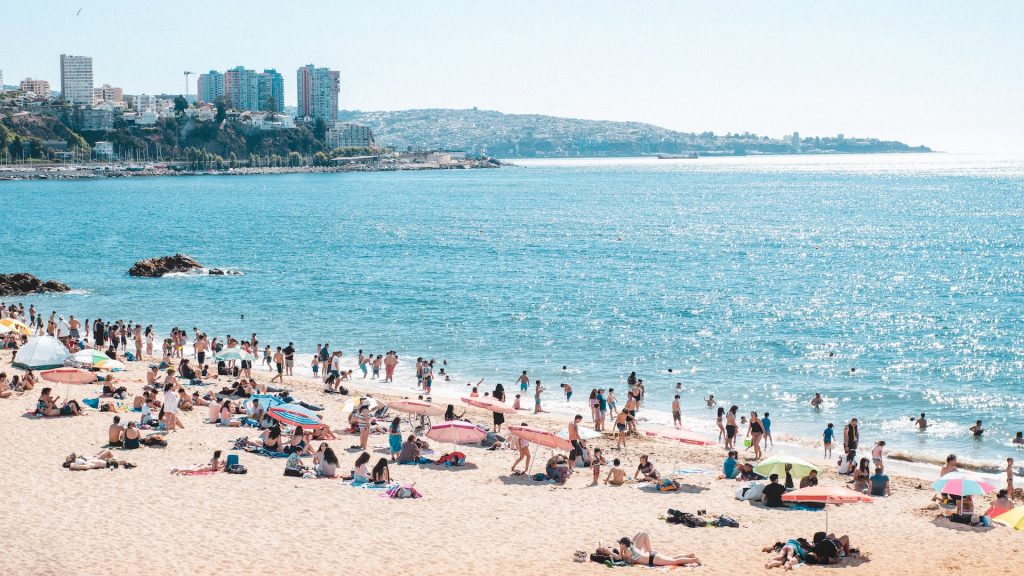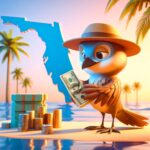If you’ve finally had enough of the cold and snow, you might be finally considering heading south this year instead. I’m going to give you the details on how to become a snowbird so that you can figure out just how to make those dreams a reality!
In the United States, places like Florida, South Carolina, and the Gulf Coast beckon to those weary of long, cold winters. Often favored by snowbirds, these regions offer warm weather and numerous attractions to fill one’s days.
However, don’t let the allure of balmy climates and sandy beaches distract you from the necessary groundwork. Nurturing a snowbird lifestyle involves much preparation, including financial considerations.
As a prospective snowbird, you’ll want to master the essence of where to live, property maintenance, and also taking care of yourself along the way. So, are you ready to learn how to become a snowbird?

Understanding the Concept of Becoming a Snowbird
The concept of becoming a snowbird doesn’t involve sprouting wings, but it does involve a major lifestyle change. It’s akin to taking flight from your primary residence and nesting somewhere warmer for a good portion of the year.
Ultimately, the objective is to evade the cold and bask in the sun while maintaining your usual routine. However, uprooting yourself for months on end isn’t as simple as packing up and taking off!
It means taking into consideration a host of factors, such as property taxes for your primary and secondary abode. Investigating the tax status of the state where you’ll be wintertime-residing is a good place to start. After all, Uncle Sam always gets his due!
What Is a Snowbird, and Why Do People Become One?
A snowbird refers to the migratory folks, often retirees, who, like winter-avoiding birds, fly south or move to warmer climes during the cold winter months. The snowbird destination could be anywhere from California to Texas, Arizona, or the Sunshine State itself—Florida.
The driving factor? Well, it comes down to avoiding the hassles associated with the cold weather, such as shoveling snow, and simply preferring to savor their retirement in a gentler, sun-kissed climate.
The charm of the snowbird lifestyle doesn’t just lie in escaping the winter chill. There are health reasons that make it attractive, too. Exposure to extreme cold weather can increase health risks, especially for those with certain conditions.
By migrating to a warmer climate, snowbirds reduce these risks. Besides, a little sunshine never hurts anyone; in fact, it can give the soul a world of good, breathing life back into those frosty bones!
Preparing the Groundwork to Become a Snowbird
Becoming a snowbird doesn’t happen overnight, and it’s not all fun and games. It’s a goal that involves detailed planning, research, setting timelines, and organizing.
One of the biggest misconceptions folks have is that snowbirds are perpetually “on vacation.” But it’s not all sunbathing and cocktail sipping; it involves the same day-to-day living responsibilities as any other lifestyle.
Nurturing a snowbird lifestyle requires a fair share of trade-offs. The appeal of escaping the winter chill for sunnier climes will always involve a bit of give and take.
However, the transition can be pretty seamless once you’ve got your ducks in a row. So, set your goals, roll your sleeves, and start planning your snowbird journey!
Pick a Place That Matches Your Day-to-Day Living
Opting for the snowbird lifestyle means spending three to four winter months away from your primary residence. So, your snowbird destination needs to jive with your everyday life. You wouldn’t pick a place where you’d feel like a fish out of water, would you?
When choosing your winter haven, consider access to amenities like grocery stores, healthcare resources, parks, and walking paths.
If you’re active, you’d also want to check out the cultural activities and hobbies you can indulge in and make sure they align with your favorites (or something new you want to try). After all, life doesn’t stop when you’re a snowbird; it just gets a bit warmer!
That’s also why many folks choose to rent seasonally when they first become a snowbird. Try out different areas and see which people, weather, and entertainment options best suit you personally!
Prioritize Your Requirements for a Snowbird Lifestyle
Before you start packing your flip-flops and sunscreen, you have to figure out what you want from this snowbird lifestyle so you can prioritize your requirements. Think of this as a checklist of everything you want in your daily living.
Remember, this isn’t a vacation, but rather a winter retreat; a lifestyle change. The priority should be finding a place that won’t interfere with your daily routines. It’s hard enough going from winter boots to flip-flops in a day! So, why not make the transition as easy as possible?
Make a list of what’s important to you in this lifestyle change. Think about your day-to-day life. Do you want a place close to golf, fishing, or shopping? How about medical facilities or restaurants – you have to eat, right? Yes, I’m talking about the nitty-gritty of normal daily life.
You might be swapping snowbanks for palm trees, but these details matter. Speaking to a financial advisor can be super helpful, too. They can guide you on how to make this lifestyle fit your financial plan. Oh, and don’t forget about considering a warm climate – it’s all about ditching winter, remember?

The Financial Aspects of Becoming a Snowbird
So, now that you’ve got this dream of heading south for the winter, let’s talk about the financial aspects of becoming a snowbird. This isn’t a move you make without checking your bank account first!
Property taxes, rental property costs, and travel or transport costs should all play a part in your decision-making. Moving isn’t cheap, and you must consider establishing a primary residence, especially if you’re considering living in a different state for part of the year.
Yeah, I know it might sound odd, but trust me, the state you choose can seriously impact your wallet. Plus, don’t forget about utilities—they have to stay on if you want to keep your place livable. There’s also the cost of food, essentials, and activities in the area to factor in.
But don’t fret, you got this! Just think of it as a big adventure. If your funds feel a little tight, learn more about how to be a snowbird on a budget for some helpful money-saving ideas!
Calculate the Costs Carefully
You’ve heard the phrase “counting your chickens before they’ve hatched,” right? Well, the same goes for becoming a snowbird. You have to calculate the costs before making any big moves. Depending on where you’re headed, the costs of taxes might look different than your home state.
You could be looking at RV parks, condos, or that cute little cottage by the beach. Each option has its own set of costs, from the price of fuel to upkeep and the ever-important travel costs. Before you hang your hat, make sure you do the math.
Another thing to think about is home improvements. You can call that run-down shack a diamond in the rough, but remember, turning it into a gem isn’t going to be cheap. A broken faucet here, a fresh coat of paint there—homeownership is full of surprises.
Snowbirding might sound like all fun in the sun, but you must be ready to handle the costs. And remember, no matter how you plan to become a snowbird, the best way to enjoy it is to prepare for the costs involved. Let’s say there’s more to this than just trading your snowmobile for a surfboard.
I have a whole guide on how snowbirds afford two homes that you can check out if you’re unsure if you’ll be able to and want to learn more!
The Critical Role of Taxes
Your new sunny paradise isn’t just about palm trees and sunsets; you also have to consider the tax status of the state you choose.
States have different income taxes, so you must do your homework. This applies whether you’re still actively working remotely, or even your retirement income. It might seem like a tiny detail now, but it could make a big difference later down the line.
Some states are tax-friendly for retirees, while others may require deep pockets. Knowing the state’s residence, property, and estate tax rules can prevent nasty surprises.
So, grab your reading glasses and research, or speak with a savvy tax advisor. Knowledge is power, and when it comes to taxes, it can also save you a few bucks!
Establishing Your Snowbird Home
Establishing your snowbird home isn’t just about picking a place; it’s about creating a space that’s your own, where you can soak up the warmer climes and forget about shoveling snow.
Think about things like if you want to own or rent, location for weather and amenities, and selecting the most advantageous location for your tax purposes. Don’t forget to check in with your postal service—you still want to get your mail, right?
Then there’s the whole business of setting up a new place: furniture, kitchen stuff, decorations, you name it. Maybe you want to opt for a fully furnished rental to cut down on that, but maybe you prefer to set up your second home or RV just the way you like.
It kind of reminds me of the thrill of getting my first apartment all over again!
Transitioning Towards the Snowbird Lifestyle
Sure, the idea of packing up your life and heading south for the winter may sound a little nerve-racking. But hey, it’s all about balance. And speaking of balance, it might be a good idea to sit with a financial advisor before you start swapping your snow boots for sandals.
They can help you see how this switch fits into your financial plan. After all, you want to ensure your retirement bucks stretch out.
And remember, transitioning isn’t a sprint. It’s a marathon. Take it slow. Do some dry runs, if you will. Spend shorter stays at your potential snowbird home and see how it feels.
The more familiar you become with your snowbird destination, the easier the transition will be. Take it from me: the change could be as smooth as a seaside breeze if you give it the right time and preparation.
Developing a Social Network as a Snowbird
Moving away from the cold weather might mean you’ll be miles away from your pals back north. Bummer, right? Not entirely. Flip the coin, and you might see a chance to start anew, meet a whole new set of folks, and expand your social network.
It’s like high school all over again, but with less drama and more potlucks. Meeting new people can bring freshness to your life, kind of like that first cup of joe in the morning—it brightens up your day.
Plus, don’t forget the old pals who might also be snowbirds. Hey, you might even have a mini-reunion in the South. Who knows? Forming or integrating into a community of like-minded people can definitely help you navigate this new chapter of life.
So, don’t worry about being the new kid on the block. Embrace it. After all, everybody loves an interesting newcomer story, don’t they?
Planning to Make New Friends in Your Snowbird Location
Making new friends is an art. You don’t just walk into a room full of people and voila! Instant friendships. It’s more subtle. Like gardening, if you will.
You have to plant the seeds of friendship, water them with conversations and shared experiences, and give them time to grow. Sounds simple enough, but it’s more nuanced when you’re in a new location.
A tip? Be active in local gatherings, be it a local book club or a beach yoga class. Joining local activities will not only help you meet potential friends, but it will also keep you active. Now, that’s a win-win, isn’t it?
Don’t be too shy to invite your new neighbors for a cup of coffee or a barbecue at your place. Remember, you’re not just becoming part of a community but also building one.

Optimizing Your Snowbird Experience: Additional Tips
When you think of optimizing your snowbird experience, imagine it as unlocking the cheat codes for the snowbird lifestyle. For one, have you thought about stretching that active lifestyle of yours beyond the borders?
The world is your oyster, my friend. You could be trekking in Costa Rica or salsa dancing in Spain. The point is, don’t limit yourself. Explore options, soak in new cultures, and stretch your horizons.
Now, if you do decide to spread your wings internationally, remember to spend an extended period at your chosen destination before making any final decision—let’s say at least three months.
This will give you a good feel of the place, its climate, and its culture, much like test-driving a car before buying it. You wouldn’t want to buy a lemon, would you? The same goes for picking a country for your snowbird lifestyle. It has to be the right fit.
Gearing Up for Your International Snowbird Lifestyle
If you’ve decided to go international, good on you! Now comes the real fun – gearing up for your international snowbird lifestyle. It’s not just packing your suitcase and jetting off. No, it takes a bit more planning and preparation.
First, you have to embrace your active lifestyle and research how to sustain it in your chosen destination. Get the scope of the place from the local cuisine to the popular sports or activities.
Also, remember that spending an extended period in a different country is not like vacationing there. Figuring out visas, navigating through a novel health care system, understanding a different tax code, and learning a new language – all these need to be factored in.
Sure, it might seem a little overwhelming. But think of it as an adventure. And hey, isn’t that what the snowbird lifestyle is all about – one big, adventurous journey?
Frequently Asked Questions
How to Become a Snowbird?
Becoming a snowbird involves careful planning and preparation. Consider factors such as your budget, desired destinations, accommodations, healthcare needs, and lifestyle preferences before making the transition.
Choose to trial different locations for a few seasons to learn what you like best before fully committing to an area.
What Are the Benefits of Becoming a Snowbird?
Becoming a snowbird offers numerous benefits, including escaping harsh winter weather, enjoying year-round outdoor activities, exploring new destinations, and experiencing a change of scenery and lifestyle.
There is also the ability to expand your friend group, try new things, and even enjoy some health benefits associated with being more active year round.
When Is the Best Time to Become a Snowbird?
The best time to become a snowbird depends on personal circumstances and preferences.
Many retirees choose to become snowbirds after retiring, while others may transition to this lifestyle earlier if they have flexible work arrangements.
Why Do People Choose to Become Snowbirds?
People choose to become snowbirds for various reasons, including seeking relief from cold weather, enjoying outdoor activities year-round, experiencing new cultures, and maintaining an active and social lifestyle.
How Can I Prepare Financially to Become a Snowbird?
Create a budget that accounts for expenses such as travel, accommodation, healthcare, insurance, and day-to-day living costs in both your home and destination.
Financial preparation is crucial before becoming a snowbird.
What Are Some Challenges of Becoming a Snowbird?
Challenges of becoming a snowbird may include adjusting to a new environment, and managing two residences.
It may also include navigating healthcare systems in different locations, and maintaining connections with family and friends.
What Should I Consider Before Making the Decision to Become a Snowbird?
Before becoming a snowbird, carefully consider factors such as your financial situation, health needs, family obligations, preferences for travel and lifestyle, and readiness to adapt to a new routine and environment.
Make sure to create a budget, list out preferences for locations based on your needs and desires, and try shorter stints at first to see if it’s a good fit.
Wrapping Up
If you want to become a snowbird, it isn’t all sunshine and daisies (though there is plenty of sunshine if you’re doing it right). You have to keep your head in the game regarding the financial stuff!
Sure, the rising cost of groceries, gas, and whatnot might make the snowbird lifestyle seem pretty pricey. The good news is it’s not as financially intimidating as it appears.
Believe me, there’s a way to enjoy winters in warm weather destinations, even on an unassuming budget. Working within financial boundaries requires some groundwork, some planning, and a hearty spirit.
These pointers should give you a leg up on your quest to become a snowbird!
- 23 Fun Things to Do for Your Birthday in Florida - May 9, 2024
- How to Be a Snowbird on a Budget: Don’t Break the Bank! - April 2, 2024
- How Do Snowbirds Afford Two Homes? A Complete Guide - March 28, 2024




